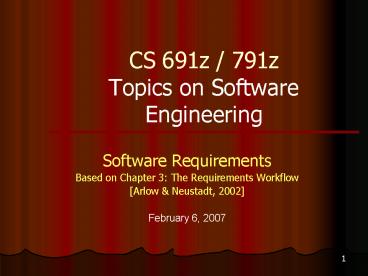CS 691z 791z Topics on Software Engineering - PowerPoint PPT Presentation
Title:
CS 691z 791z Topics on Software Engineering
Description:
The SRS (Systems Requirements Specification) is the document that contains the ... In requirements specification we need to identify the application of the above ... – PowerPoint PPT presentation
Number of Views:45
Avg rating:3.0/5.0
Title: CS 691z 791z Topics on Software Engineering
1
CS 691z / 791zTopics on Software Engineering
- Software Requirements
- Based on Chapter 3 The Requirements Workflow
- Arlow Neustadt, 2002
- February 6, 2007
2
Outline
- Requirements
- The requirements workflow
- Metamodel for software requirements
- Requirements workflow details
- The importance of requirements
- Defining requirements
3
The Requirements Workflow.
Fig. 3.2 Arlow Neustadt, 2002 shows that most
of the work in requirements workflow occurs in
Inception and Elaboration phases
4
.The Requirements Workflow
- The purpose of the requirements workflow is to
reach an agreement on what the system should do,
expressed in a way accessible to the users of the
system - Requirements engineering involves elicitation,
negotiation, conflict resolution, prioritization,
documentation, and maintenance of requirements - Various stakeholders are involved in establishing
the set of requirements for the system - UML uses cases describe functional requirements,
but non-functional requirements need different
description
5
Metamodel for Software Requirements
- Arlow Neustadts approach for requirements
engineering is shown in - Fig. 3.3 Arlow 2002. Details can be found in
Section 3.3
6
Requirements Workflow Detail.
- Specific tasks for UP (Unified Process)
requirements workflow - Fig. 3.4 Arlow Neustadt 2002
7
.Requirements Workflow Detail
- Arlow and Neustadt extend slightly the UP
requirements workflow with - the addition of new tasks find functional
requirements, find non- - functional requirements, prioritize requirements,
trace requirements - to use cases. As such, non-functional
requirements can be addressed - as well, along with the traditional UP/UML
treatment of functional - requirements via use cases. Fig. 3.5 Arlow
Neustadt 2002
8
The Importance of Requirements
- Requirements engineering is about establishing
what the stakeholders need from the system - Requirements engineering encompasses elicitation,
negotiation, conflict resolution, prioritization,
documentation, and maintenance of requirements - Poor requirements engineering is the major cause
of software project failure - The second major cause of software project
failure is lack of user participation
9
Defining Requirements
- Requirement a specification of what should be
implemented - There are two types of requirements
- Functional requirements describe the desired
behaviour of the system - Non-functional requirements specify particular
properties of or constraints on the system - In theory, the set of requirements should be only
about what the system should do, but in
practice it is not possible to avoid how
aspects of the system
10
.Defining Requirements..
- The SRS (Systems Requirements Specification) is
the document that contains the set of
requirements expected to be satisfied by the
system, both functional and non-functional - There are many ways to write a SRS (company
dependent ways) - The SRS provides the input for the analysis and
design phases of the development process - The bottom line regarding the SRS is does it
help me to understand what the system should do
or not?
11
..Defining Requirements.
- Simple format recommended for well-formed
requirements - ltidgt The ltsystemgt shall ltfunctiongt
- Examples of functional requirements (what the
system should do) - 1 The ATM shall check the validity of the ATM
card inserted. - 2 The ATM shall validate the PIN number entered
by the client. - Examples of non-functional requirements
(constraints on or properties of the system) - 1 The ATM shall be written in C.
- 2 The ATM shall validate the PIN in three
seconds or less.
12
Defining Requirements
- The map is not the territory (that is, a model
is not the real thing). When modeling, we apply
three cognitive filters that simplify our effort
Chomsky, 1975 - Deletion
- Distortion
- Generalization
- In requirements specification we need to identify
the application of the above filters and find
challenges for them to recover information - In particular, universal quantifiers such as all,
everyone, always, never, nobody, none should be
inspected closely for accuracy































